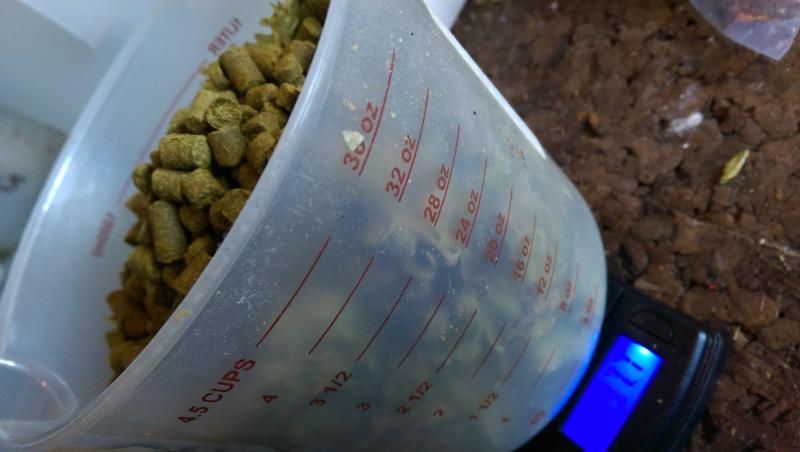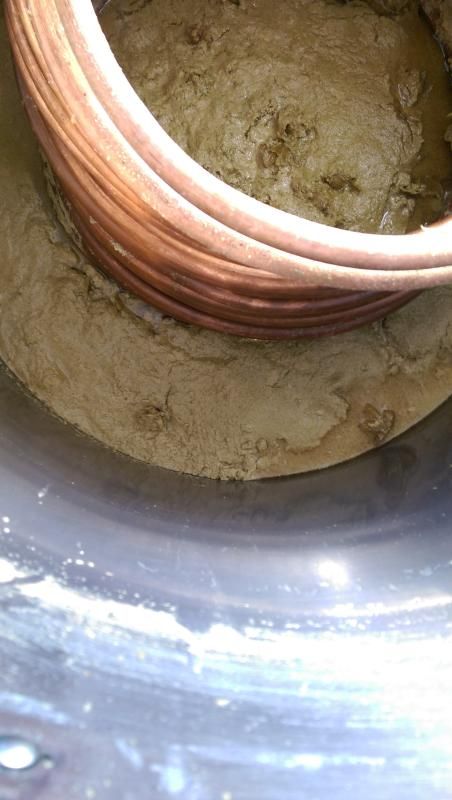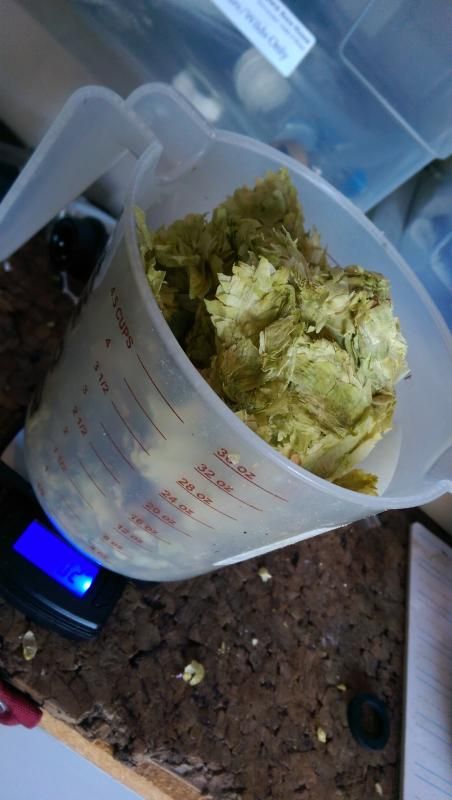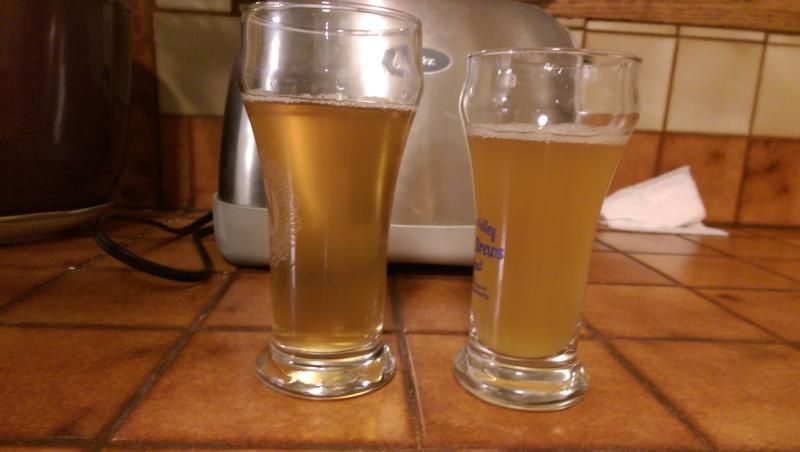 |
| 7 oz Whirlpool Hops for 10 gallons |
Thus it begins. The process I swore I would never do. Rebrewing a recipe with tweeks. I have day dreamed of owning my own brewery someday, and have declared that I would never have house beers, the same recipe brewed over and over again. But then the day dreams are seeming to become more serious. I recently felt led to step out of ministry, that youth ministry is not where the Lord is calling me. In the midst of this, I have been wondering where my calling may actually be. My pastors have stated that they are excited to see where the Lord uses me in the future, and they all hope it is in brewing. Then my wife buys me Starting Your Own Brewery, 2nd Edition for Christmas (a super expensive book), seems like she is behind the idea. In light of all this - the possibility of actually owning a brewery - the thought of having solidified recipes, house beers, repeatable, excellent, it all comes rushing in. Regardless of whether I actually have year round house beers or not, I need a solid recipe to give potential investors, something repeatable and unique, something I can brew on a big boy system and know if I did it right or not. Thus it begins. Rebrewing a recipe with tweeks.
 One of the best IPAs I have made to date was for our church's Fall Harvest Party in October. That beer was great but could use a few tweeks. First, I added way too much lactic acid to the sparge water and so the beer had a light tart edge, no biggy. Second, if I am trying to hone in on a recipe to brew commercially, whether as a rotating house beer (seasonal IPAs, changing recipe for each season) or for a year round production beer, I can't really use a hop only home-growers have: Blisk. This is sad since this hop is wonderful in an IPA, but it is not produced on a commercial scale, so I need to use a hop I can actually buy. Then the third change, what if I did Brett instead of Cal Ale? Brett Trois (or maybe a wild Sacc strain) brings a whole new dimension to hoppy beers, and this strain in particular plays up the tropical notes which is great when you can't get large amounts of the super tropically hops nowadays.
One of the best IPAs I have made to date was for our church's Fall Harvest Party in October. That beer was great but could use a few tweeks. First, I added way too much lactic acid to the sparge water and so the beer had a light tart edge, no biggy. Second, if I am trying to hone in on a recipe to brew commercially, whether as a rotating house beer (seasonal IPAs, changing recipe for each season) or for a year round production beer, I can't really use a hop only home-growers have: Blisk. This is sad since this hop is wonderful in an IPA, but it is not produced on a commercial scale, so I need to use a hop I can actually buy. Then the third change, what if I did Brett instead of Cal Ale? Brett Trois (or maybe a wild Sacc strain) brings a whole new dimension to hoppy beers, and this strain in particular plays up the tropical notes which is great when you can't get large amounts of the super tropically hops nowadays.
Of course, making all of these changes at once won't let me know exactly which change solicited each shift in flavor and aroma. There needs to be some way to know what removing the acid snaffoo and changing out one hop for another is. Thus I brewed a 10 gallon batch of the new recipe, and pitched the same yeast from the first beer into one fermentor, and pitched the Brett into the other. This way I can judge the hop change from beer 1 to beer 2, and then also judge the yeast change from beer 2 to beer 3. From here I will evaluate it again and see what other changes I might want to make. If I like one or the other more, I will begin trials on pitching rates/cell counts, fermentation temps, dial in bittering and hopping rates, etc. One other major tweek was to do this as a typical 60 minute mash as opposed to an overnight since that would be the reality in a brewery.
________________________Stats: Brett / Cal
Gallons: 5.25 5.25
OG: 1.059 1.059
FG: 1.010 1.007
ABV: 6.4% 6.8%
IBUs: 77 77
SRM: 6 6
Efficiency: 74% 74%
________________________
Fermentables:
22.00 # Pale Malt (Great Western) ( 81.6%)
1.65 # Cara-Pils/Dextrine ( 6.1%)
 1.10 # British Carastan – 30/37L ( 4.1%)
1.10 # British Carastan – 30/37L ( 4.1%) 2.20 # Sugar, Dememera ( 8.2%)
Mash 1 hours @ 151
________________________
Boil 60 mins:
60 3.50 oz Magnum 13.70%AA
30 2.00 oz Centennial 9.50%AA (Pellet)
15 2.00 oz Chinook 14.20%AA (Pellet)
WP 25 @ 180*F 3.00 oz Amarillo 8.40%AA (Pellet)
WP 25 @ 180*F 2.00 oz CTZ 15.80%AA (Pellet)
WP 25 @ 180*F 2.00 oz Chinook 12.00%AA
DH 1.00 oz CTZ 10.00%AA (Pellet)
DH 2.00 oz Centennial 12.00%AA
DH 3.00 oz Amarillo 9.50%AA (Pellet)
DH 2.00 oz Chinook 12.00%AA
________________________
Kettle Additions:
Ca 107.1 Mg 30.0 Na 6.1 SO4 267.3 Ch 2.4 Bi-Carb 148.7
pH 5.51
Yeast Nutrient 0.5 tsp
Whirfloc 1 each
 ________________________
________________________Fermentation:
Cooled to: 76 *F
Cal Ale (Oakshire Slurry) / Brett Brux Trois
70*F 2 days
72*F 2 days
75*F 12 days
40*F 3 days
68*F 4 days (Dry Hop in Keg)
________________________
12/13 Mashed in at 151*F for 60 minutes, plus a 15 minute vorlauf with the pump. Added hops directly to the kettle per recipe. Chilled to 76*F. The break and hop material sealed the strainer shut leading to a thin trickle of wort into the fermentors, but it was super clear. Had to sanitize my glove and scrape off the gunk from the strainer. While I waited for this I added some boiled/chilled wort to my decanted starters and gave them lots of shakes to get the yeast active and ready to roll. Pitched yeast at 76*F, and cooled to 70*F, krausen forming just over 6 hours in. Rocking at 11 hours.
 |
| 4 oz Dry Hops for 5 gallons |
12/15 Upped temp to 72*F
12/17 Upped to 75*F (cold snap kept it between 72-75).
12/20 Gravity sample shows Brett version at 1.019.
12/23 Brett down to 1.015, Cal Ale down to 1.010.
12/29 Brought temp down to 72*F
12/30-31 Took off heater and allowed to drop temp and cool.
1/1/15 Kegged with hops suspended inside keg, racked via CO2 through dip tube to purged keg. Placed in laundry room to absorb hop oils at room temp (too cold in garage and beer lounge). Cal Ale version is already super clear, which isn't typically normal this young.
1/5 Odd taste in the Cal Ale version, very vegetal, like hop hash and tomato juice. A buddy of mine had this happen and it cleared up for him. Might just blast this with CO2 from the bottom and off-gas it when moved to the new keezer I just built.
1/5 Odd taste in the Cal Ale version, very vegetal, like hop hash and tomato juice. A buddy of mine had this happen and it cleared up for him. Might just blast this with CO2 from the bottom and off-gas it when moved to the new keezer I just built.
1/8 Kegs moved to new keezer and placed on CO2 to carb, Cal Ale got CO2 from the liquid dip tube bubbled up to off gas the vegetal character.



No comments:
Post a Comment